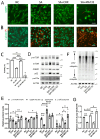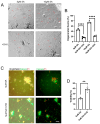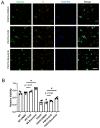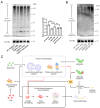Chronic Oxidative Stress and Stress Granule Formation in UBQLN2 ALS Neurons: Insights into Neuronal Degeneration and Potential Therapeutic Targets
- PMID: 39769213
- PMCID: PMC11678478
- DOI: 10.3390/ijms252413448
Chronic Oxidative Stress and Stress Granule Formation in UBQLN2 ALS Neurons: Insights into Neuronal Degeneration and Potential Therapeutic Targets
Abstract
The pathogenesis of neurodegenerative diseases results from the interplay between genetic and environmental factors. Aging and chronic oxidative stress are critical contributors to neurodegeneration. UBQLN2, a ubiquitin-related protein, aids in protein degradation and protects against oxidative stress. In ALS neurons harboring UBQLN2 mutations, oxidative stress accelerates pathological changes, yet the precise mechanisms remain unclear. Using induced motor neurons (iMNs) derived from UBQLN2 P497H iPSCs, we observed ALS-like phenotypes, including TDP-43 mislocalization, increased cell death, and reduced viability. Sodium arsenite (SA)-induced oxidative stress triggered stress granule formation, while autophagy dysfunction exacerbated neuronal degeneration. CHX and bosutinib treatments reduced ubiquitinated protein accumulation and alleviated degeneration, highlighting potential therapeutic pathways. These findings emphasize the role of chronic oxidative stress and stress granule formation in UBQLN2 ALS, offering insights into novel therapeutic targets.
Keywords: ALS; UBQLN2; motor neurons; neurodegenerative diseases; oxidative stress; stress granule.
Conflict of interest statement
The authors declare no conflicts of interest.
Figures








Similar articles
-
Damaged DNA Is an Early Event of Neurodegeneration in Induced Pluripotent Stem Cell-Derived Motoneurons with UBQLN2P497H Mutation.Int J Mol Sci. 2022 Sep 26;23(19):11333. doi: 10.3390/ijms231911333. Int J Mol Sci. 2022. PMID: 36232630 Free PMC article.
-
Amyotrophic lateral sclerosis (ALS) linked mutation in Ubiquilin 2 affects stress granule assembly via TIA-1.CNS Neurosci Ther. 2022 Jan;28(1):105-115. doi: 10.1111/cns.13757. Epub 2021 Nov 8. CNS Neurosci Ther. 2022. PMID: 34750982 Free PMC article.
-
UBQLN2 in neurodegenerative disease: mechanistic insights and emerging therapeutic potential.Biochem Soc Trans. 2025 Aug 29;53(4):823-833. doi: 10.1042/BST20253053. Biochem Soc Trans. 2025. PMID: 40663766 Review.
-
Mutant UBQLN2P497H in motor neurons leads to ALS-like phenotypes and defective autophagy in rats.Acta Neuropathol Commun. 2018 Nov 8;6(1):122. doi: 10.1186/s40478-018-0627-9. Acta Neuropathol Commun. 2018. PMID: 30409191 Free PMC article.
-
Key role of UBQLN2 in pathogenesis of amyotrophic lateral sclerosis and frontotemporal dementia.Acta Neuropathol Commun. 2019 Jul 18;7(1):103. doi: 10.1186/s40478-019-0758-7. Acta Neuropathol Commun. 2019. PMID: 31319884 Free PMC article. Review.
References
-
- Belbasis L., Bellou V., Evangelou E. Environmental Risk Factors and Amyotrophic Lateral Sclerosis: An Umbrella Review and Critical Assessment of Current Evidence from Systematic Reviews and Meta-Analyses of Observational Studies. Neuroepidemiology. 2016;46:96–105. doi: 10.1159/000443146. - DOI - PubMed
MeSH terms
Substances
Grants and funding
LinkOut - more resources
Full Text Sources
Medical
Miscellaneous

